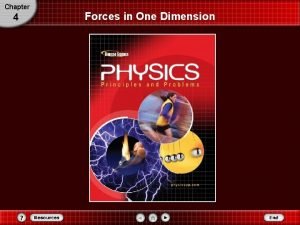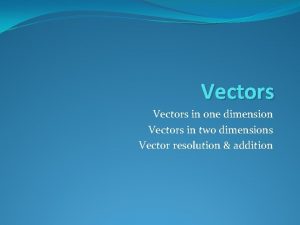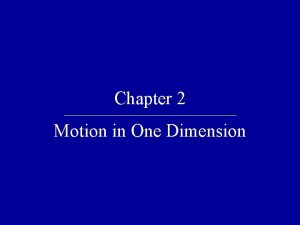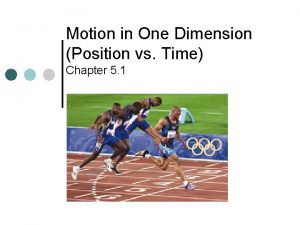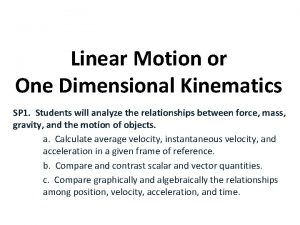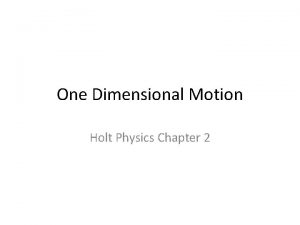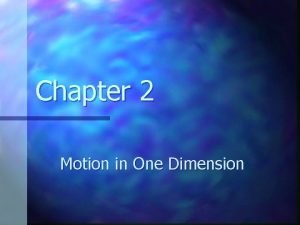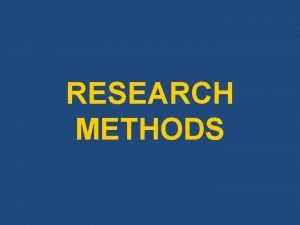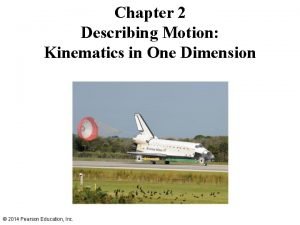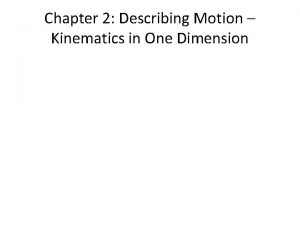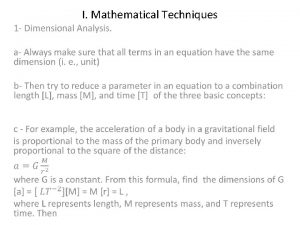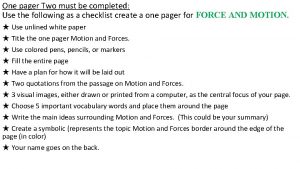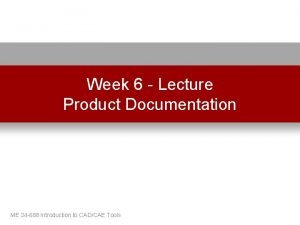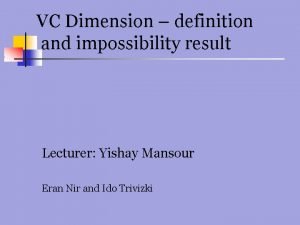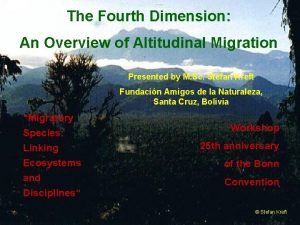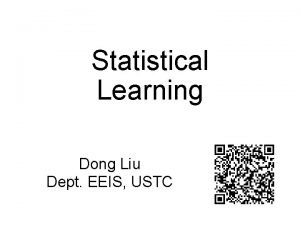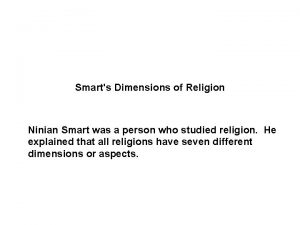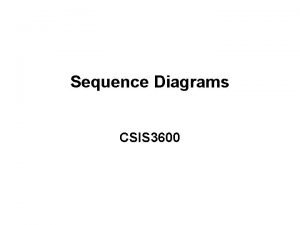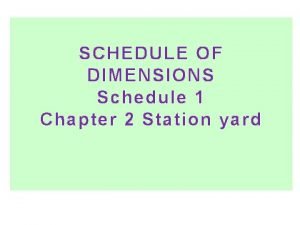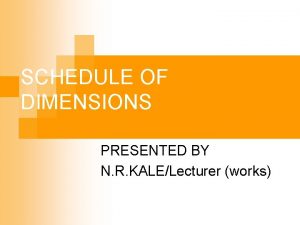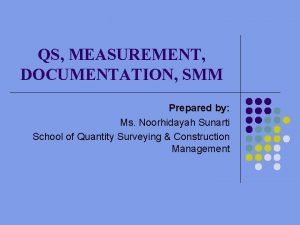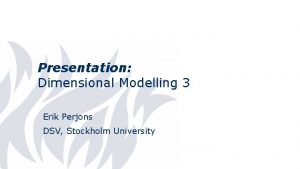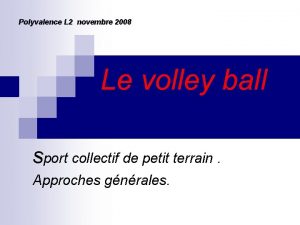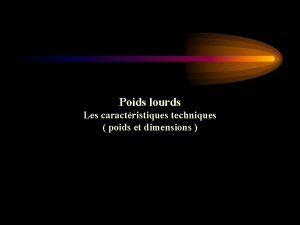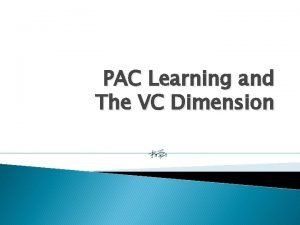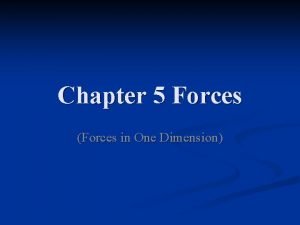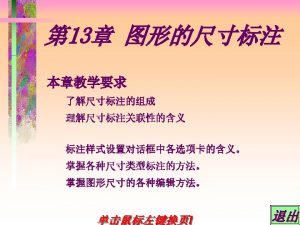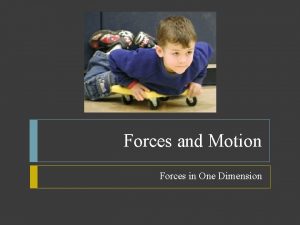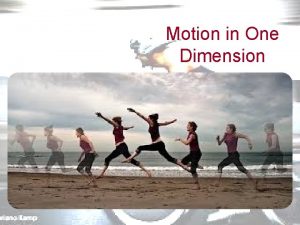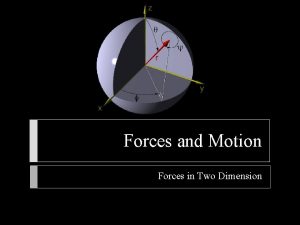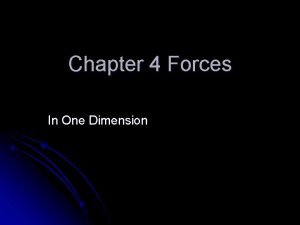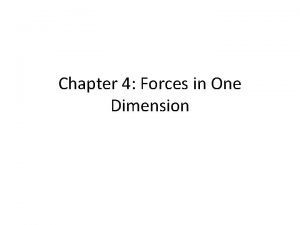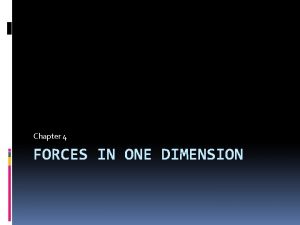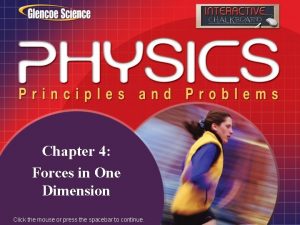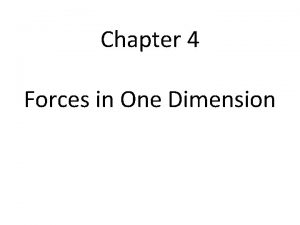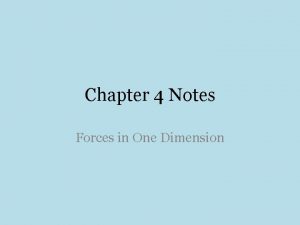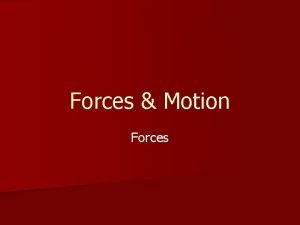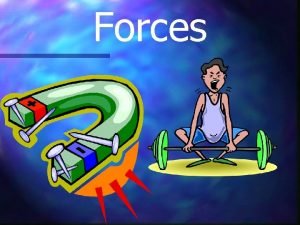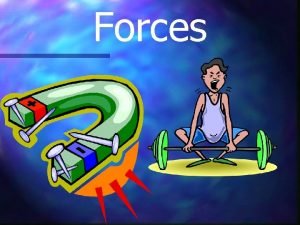Chapter 4 Forces in One Dimension Chapter 4






















































- Slides: 54

Chapter 4 Forces in One Dimension

Chapter 4 Forces in One Dimension In this chapter you will: Use Newton’s laws to solve problems. Determine the magnitude and direction of the net force that causes a change in an object’s motion. Classify forces according to the agents that cause them. *VD Note

Chapter 4 Forces in One Dimension Homework For Chapter 4: Read Chapter 4 Study Guide Chapter 4 HW 4. A: Handout HW 4. B: Handout

Chapter 4 Table of Contents Chapter 4: Forces in One Dimension Section 4. 1: Force and Motion Section 4. 2: Using Newton's Laws Section 4. 3: Interaction Forces

Section 4. 1 Force and Motion Section 4. 1: Force and Motion

Section 4. 1 Force and Motion Warmup: Force and Motion Consider a washer resting on a table. How can you cause it to move? Two possibilities are that you can push on it or you can pull on it. The push or pull is a force that you exert on the washer. If you push harder on an object, you have a greater effect on its motion. The direction in which force is exerted also matters. If you push the washer to the right, it moves towards right. The symbol F (bold type) is a vector and represents the size and direction of a force, while F (normal type) represents only the magnitude.

Section Force and Motion 4. 1 In this section you will: Define force. Learn how to draw a free-body diagram. Explain the meaning of Newton’s first law. Apply Newton’s second law to solve problems.

Section 4. 1 Force and Motion • kinematics – the study of how objects move – Galileo’s focus of study • dynamics – the study of why objects move the way they do – Newton’s focus of study

Section 4. 1 Force and Motion A force is defined as a push or pull exerted on an object. A force is a vector; it has magnitude and direction. Forces can cause objects to speed up, slow down, or change direction as they move. Based on the definitions of velocity and acceleration, a force exerted on an object causes that object’s velocity to change; that is, a force causes an acceleration. The unit of force is the newton (N). 1 newton = 1 kg · m s 2

Section 4. 1 Force and Motion When considering how a force affects motion, it is important to identify the object of interest. This object is called the system. Everything around the object that exerts forces on it is called the external world.

Section 4. 1 Force and Motion Contact Forces and Field Forces Think about the different ways in which you could move a textbook. You could touch it directly and push or pull it, or you could tie a string around it and pull on the string. These are examples of contact forces. A contact force exists when an object from the external world touches a system and thereby exerts a force on it.

Section 4. 1 Force and Motion Contact Forces and Field Forces If you drop a book, the gravitational force of Earth causes the book to accelerate, whether or not Earth is actually touching it. This is an example of a field force. Field forces are exerted without contact. Forces result from interactions; thus, each force has a specific and identifiable cause called the agent. Without both an agent and a system, a force does not exist. A physical model which represents the forces acting on a system, is called a free-body diagram.

Section 4. 1 Force and Motion How to Draw a Free-body Diagram 1. Represent the object you are analyzing with a dot. 2. Identify any places of contact with the physical world, visible (ex: string tension) or invisible (ex: gravity) 3. At each point of contact there is a force acting on the dot. Draw an arrow away from the dot at that point, and label the force. 4. Draw long arrows for large forces and short arrows for small forces. 5. Choose the positive direction to be in the direction of the greatest amount of force. Label it on your diagram. Practice Problems p. 89: 1 -5

Section 4. 1 Force and Motion Contact Forces and Field Forces p. 91

Section 4. 1 Some of the common types of forces are displayed on the right. When analyzing forces and motion, it is important to keep in mind that the world is dominated by resistance. Newton’s ideal, resistance-free world is not easy to visualize.

Section 4. 1 Force and Motion Combining Forces When the force vectors are in the same direction, they can be replaced by a vector with a length equal to their combined length. If the forces are in opposite directions, the resulting vector is the length of the difference between the two vectors, in the direction of the greater force. Vector sum of all the forces on an object is net force. - net force can also be written Fnet or F - It is calculated using vector addition. Fnet = F 1 + F 2 +…+ Fn

Section 4. 1 Example 1: Combining Forces a) Place a book on the table and push it to the right with a force of 10 newtons. Determine the force being applied to the book due to pushing. (10 newtons right or +10 N) b) Push the book with a force of 10 newtons to the right and 10 newtons to the left. Determine the total force applied to the book due to pushing. (Zero newtons or 0 N) c) Push the book with a force of 8 newtons to the right and 10 newtons to the left. Determine the total force applied to the book due to pushing. (2 newtons left or -2 N)

Section 4. 1 Example 2: Combining Forces p. 92 If you and your friend exert a force of 100 N each on a table, first in the same direction and then in the opposite directions, what is the net force? In the first case, your friend is pushing with a negative force of 100 N. Adding them together gives a total force of 0 N. In the second case, your friend’s force is 100 N, so the total force is 200 N in the positive direction and the table accelerates in the positive direction.

Section 4. 1 Force and Motion Newton’s First Law What is the motion of an object with no net force acting on it? A stationary object with no net force acting on it will stay at its position. Galileo did many experiments, and he concluded that in the ideal case of zero resistance, horizontal motion would never stop. Galileo was the first to recognize that the general principles of motion could be found by extrapolating experimental results to the ideal case, in which there is no resistance to slow down an object’s motion.

Section 4. 1 Force and Motion Newton’s First Law In the absence of a net force, the motion (or lack of motion) of both the moving object and the stationary object continues as it was. Newton recognized this and generalized Galileo’s results in a single statement. This statement, “an object that is at rest will remain at rest, and an object that is moving will continue to move in a straight line with constant speed, if and only if the net force acting on that object is zero, ” is called Newton’s first law.

Section 4. 1 Force and Motion Newton’s First Law Newton’s first law is sometimes called the law of inertia. Inertia is the tendency of an object to resist change. If an object is at rest, it tends to remain at rest. If it is moving at a constant velocity, it tends to continue moving at that velocity. Forces are results of interactions between two objects; they are not properties of single objects, so inertia cannot be a force.

Section 4. 1 Force and Motion Newton’s First Law If the net force on an object is zero, then the object is in equilibrium. It occurs when F = 0 or net force acting on an object is zero. An object is in equilibrium if it is at rest or if it is moving at a constant velocity. Newton’s first law identifies a net force as something that disturbs the state of equilibrium. Thus, if there is no net force acting on the object, then the object does not experience a change in speed or direction and is in equilibrium.

Section 4. 1 Force and Motion Newton’s Second Law The observation that acceleration of an object is proportional to the net force exerted on it and inversely proportional to its mass is the Newton’s second law, which can be represented in the following equation. Fnet = ma Newton’s second law states that the acceleration of an object is equal to the sum of the forces acting on the object, divided by the mass of the object. It can also be written a = F/m or m = F/a

Section 4. 1 Force and Motion Force and Acceleration The formula, F = ma, tells you that if you double the force, you will double the object’s acceleration. If you apply the same force to several different objects, the one with the most mass will have the smallest acceleration and the one with the least mass will have the greatest acceleration.

Section 4. 1 Force and Motion Newton’s Second Law: Example Assume that the table that you and your friend were pushing was 15. 0 kg and the two of you each pushed with a force of 50. 0 N in the same direction. To find out what the acceleration of the table would be, calculate the net force, 50. 0 N + 50. 0 N = 100. 0 N, and apply Newton’s second law by dividing the net force of 100. 0 N by the mass of the table, 15. 0 kg, to get an acceleration of 6. 67 m/s 2.

Section 4. 1 Force and Motion Newton’s Second Law Here is a useful strategy for finding how the motion of an object depends on the forces exerted on it. First, identify all the forces acting on the object. Draw a free-body diagram showing the direction and relative strength of each force acting on the system.

Section 4. 1 Force and Motion Newton’s Second Law Then, add the forces to find the net force. Next, use Newton’s second law to calculate the acceleration. Finally, if necessary, use kinematics to find the velocity or position of the object.

Section Check 4. 1 Question 1 Two horses are pulling a 100 -kg cart in the same direction, applying a force of 50 N each. What is the acceleration of the cart? A. 2 m/s 2 B. 1 m/s 2 C. 0. 5 m/s 2 D. 0 m/s 2

Section 4. 1 Answer: B Section Check

Section Check 4. 1 Question 2 Two friends Mary and Maria are trying to pull a 10 -kg chair in opposite directions. If Maria applied a force of 60 N and Mary applied a force of 40 N, in which direction will the chair move and with what acceleration? A. The chair will move towards Mary with an acceleration of 2 m/s 2. B. The chair will move towards Mary with an acceleration of 10 m/s 2. C. The chair will move towards Maria with an acceleration of 2 m/s 2. D. The chair will move towards Maria with an acceleration of 10 m/s 2.

Section 4. 1 Section Check Answer 2 Answer: C Reason: Since the force is applied in opposite direction, if we consider Maria’s direction of pull to be positive direction then, net force = 60 N – 40 N = 20 N. Thus, the chair will move towards Maria with an acceleration.

Section 4. 1 Section Check Question 3 State Newton’s first law.

Section 4. 1 Section Check Answer 3 Newton’s first law states that “an object that is at rest will remain at rest, and an object that is moving will continue to move in a straight line with constant speed, if and only if the net force acting on that object is zero”.

Section 4. 1 Force and Motion Section 4. 2: Using Newton’s Laws

Chapter 4. 2 Using Newton's Laws In this section you will: Describe how the weight and the mass of an object are related. Differentiate between actual weight and apparent weight.

Chapter 4. 2 Using Newton's Laws Warmup: Which Way to Go? The forces that act upon any object at any given time determine the motion (or lack of motion) of that object. The key to analyzing that motion is to correctly identify each of the forces acting and the direction in which it is acting. In each situation described below, draw and label a freebody diagram for the underlined object. 1. A box is sitting on a table. 2. A person lifts a laundry basket upward. 3. A sled slows down as it slides across the street in this direction: →

Chapter 4. 2 Using Newton's Laws Warmup: Which Way to Go? Ftable 1. A box is sitting on a table. Fgravity Flift 2. A person lifts a laundry basket upward. Fgravity 3. A sled slows down as it slides Fstreet across the street in this direction: → Ffriction Fgravity

Section 4. 2 Using Newton's Laws Using Newton’s Second Law Newton’s second law tells you that the weight force, Fg, exerted on an object of mass m is Fg = mg Consider a free-falling ball in midair. It is touching nothing and air resistance can be neglected, the only force acting on it is Fg.

Section 4. 2 Using Newton's Laws Using Newton’s Second Law The ball’s acceleration is g. So, Newton’s second law, then becomes Fg = mg. Both the force and the acceleration are downward. The magnitude of an object’s weight is equal to its mass times the acceleration due to gravity.

Section 4. 2 Using Newton's Laws Apparent Weight

Section 4. 2 Using Newton's Laws Using Newton’s Second Law Example, p. 100 How does a bathroom scale work? When you stand on the scale, the spring in the scale exerts an upward force on you because you are in contact with it. Because you are not accelerating, the net force acting on you must be zero. The spring force, Fsp, upwards must be the same magnitude as your weight, Fg, downwards.

Section 4. 2 Using Newton's Laws Example Problem : Fighting Over a Toy Anudja is holding a stuffed dog, with a mass of 0. 30 kg, when Sarah decides that she wants it and tries to pull it away from Anudja. If Sarah pulls horizontally on the dog with a force of 10. 0 N and Anudja pulls with a horizontal force of 11. 0 N, what is the horizontal acceleration of the dog?

Section 4. 2 Using Newton's Laws Fighting Over a Toy Sketch the situation and identify the dog as the system and the direction in which Anudja pulls as positive.

Section 4. 2 Using Newton's Laws Fighting Over a Toy Identify known and unknown variables. Known: Unknown: m = 0. 30 kg a=? FAnudja on dog = 11. 0 N FSarah on dog = 10. 0 N

Section 4. 2 Fighting Over a Toy Use Newton’s second law to solve for a. Substitute Fnet= FAnudja on dog+ (–FSarah on dog)

Section 4. 2 Fighting Over a Toy Substitute FAnudja on dog = 11. 0 N, FSarah on dog = 10. 0 N, m = 0. 30 kg

Section 4. 2 Using Newton's Laws Fighting Over a Toy Are the units correct? m/s 2 is the correct unit for acceleration. Does the sign make sense? The acceleration is in the positive direction because Anudja is pulling in the positive direction with a greater force than Sarah is pulling in the negative direction. Is the magnitude realistic? It is a reasonable acceleration for a light, stuffed toy.

Section 4. 2 Using Newton's Laws Fighting Over a Toy The steps covered were: Step 1: Analyze and Sketch the Problem – Sketch the situation. – Identify the dog as the system and the direction in which Anudja pulls as positive. – Draw the free-body diagram. Label the forces. Step 2: Solve for the Unknown Step 3: Evaluate the Answer

Section 4. 2 Drag Force and Terminal Velocity When an object moves through any fluid, such as air or water, the fluid exerts a drag force on the moving object in the direction opposite to its motion. A drag force is the force exerted by a fluid on the object moving through the fluid. This force is dependent on the motion of the object, the properties of the object, and the properties of the fluid (viscosity and temperature) that the object is moving through. As the ball’s velocity increases, so does the drag force. The constant velocity that is reached when the drag force equals the force of gravity is called the terminal velocity.

Section 4. 2 Using Newton's Laws Drag Force and Terminal Velocity

Section Check 4. 2 Question 1 If mass of a person on Earth is 20 kg, what will be his mass on moon? (Gravity on Moon is six times less than the gravity on Earth. ) A. B. C. D.

Section 4. 2 Section Check Answer 1 Answer: C Reason: Mass of an object does not change with the change in gravity, only the weight changes.

Section Check 4. 2 Question 2 Your mass is 100 kg, and you are standing on a bathroom scale in an elevator. What is the scale reading when the elevator is falling freely? A. B. C. D.

Practice Problems and Section Review • p. 104 20 -21 • p. 105 22 -26
 Chapter 4: forces in one dimension answer key
Chapter 4: forces in one dimension answer key 4-1 forces and acceleration
4-1 forces and acceleration Chapter 2 motion in one dimension answer key
Chapter 2 motion in one dimension answer key Difference between like and unlike parallel forces
Difference between like and unlike parallel forces The forces shown above are pushing/pulling forces
The forces shown above are pushing/pulling forces Intramolecular forces
Intramolecular forces Similarities of intermolecular and intramolecular forces
Similarities of intermolecular and intramolecular forces Intermolecular force of attraction
Intermolecular force of attraction Contact force
Contact force Force examples in everyday life
Force examples in everyday life What are destructive forces
What are destructive forces Vectors in one dimension
Vectors in one dimension Motion in one dimension quiz
Motion in one dimension quiz To describe a position in more than one dimension
To describe a position in more than one dimension Ticker tape diagram
Ticker tape diagram Holt physics motion in one dimension answers
Holt physics motion in one dimension answers Free fall motion in one dimension
Free fall motion in one dimension Which of the following is an undefined term
Which of the following is an undefined term The time dimension
The time dimension Motion in one dimension
Motion in one dimension Describing motion kinematics in one dimension
Describing motion kinematics in one dimension Describing motion kinematics in one dimension
Describing motion kinematics in one dimension Horizontal y vertical
Horizontal y vertical Motion in one dimension
Motion in one dimension One god one empire one emperor
One god one empire one emperor One one one little dog run
One one one little dog run One king one law one faith
One king one law one faith One empire one god one emperor
One empire one god one emperor Ford one plan
Ford one plan See one do one teach one
See one do one teach one One price policy
One price policy One face one voice one habit and two persons
One face one voice one habit and two persons See one do one teach one
See one do one teach one Asean tourism strategic plan
Asean tourism strategic plan One vision one identity one community
One vision one identity one community Complex machine
Complex machine Decimal tolerance chart
Decimal tolerance chart Vc dimension of neural networks
Vc dimension of neural networks Vc dimension explained
Vc dimension explained Dimension psicologica de la sexualidad humana
Dimension psicologica de la sexualidad humana Fourth dimension immigration
Fourth dimension immigration Storage cell dimension
Storage cell dimension Vc dimension
Vc dimension Ninian smarts dimensioner
Ninian smarts dimensioner The vertical dimension of sequence diagram shows
The vertical dimension of sequence diagram shows Schedule of dimensions
Schedule of dimensions A class odc speed
A class odc speed Relational dimension of communication
Relational dimension of communication Dimension paper
Dimension paper Ejemplos de dimensión comunitaria en la escuela
Ejemplos de dimensión comunitaria en la escuela Animadoras infantiles xxx
Animadoras infantiles xxx Degenerate dimension
Degenerate dimension Terrain volleyball dimension
Terrain volleyball dimension Longueur d'un poids lourd
Longueur d'un poids lourd Pac dimension
Pac dimension

